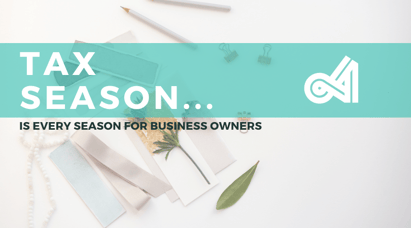
(For Businesses Too Big to Avoid Them and Too Small to Evade Them)
For Modern Brands and Businesses
 Accountfully's Guide to Taxes:
Accountfully's Guide to Taxes:Click on the thumbnail image to download the full guide.
In this guide you will learn:

While there are many things a growing business cannot predict – customer behavior, product performance, employee retention – there is always one certainty: taxes.
In theory, every for-profit business in America is liable for its fair share of the taxes used to pave roads and fund fire departments. But many businesses pay very little in taxes and some pay none at all. That’s because many small (and some large) businesses operate at a loss or invested revenue in such a way that the business showed no real taxable income. On the other end of the spectrum, many large (and some small) businesses leverage loopholes, incentives, geographic advantages and other strategies to avoid taxation altogether.
According to a study by the Government Accountability Office (GAO), more than 40 percent of large US corporations (those with at least $10 million in assets) paid no federal corporate income tax in 2012. However, avoiding taxes is a complicated effort that often involves expensive lawyers and the clout that comes with a large workforce or a popular product.
The dilemma for many businesses is simple – they are too profitable to be exempt from taxes yet too small to exploit exotic tax avoidance strategies. On top of all that, many of those same businesses do not employee a full-time accountant, much less an experienced tax expert.
Despite the enormous expense (often one of the largest annual line items) and absolute certainty that taxes must be paid, many CEOs spend very little time thinking about them. Taxes are boring and often unrelated to what CEOs were trained to do. Many of those CEOs simply hope that growing the company will allow them to outrun their tax liability with profits. It’s a foolish and expensive approach.
That’s why any company facing taxation must adopt a year-round tax strategy instead of merely bracing for a year-end surprise. Moreover, hiring in-house accounting talent isn’t the solution if it doesn’t result in a strategic view of taxation and fundamental appreciation of how taxes influence decisions.
A solid strategic view hinges on three key data points: obligations, outcomes and implications. Tracking these variables empowers any business leader to make better choices about investing in real estate, staff or anything else. It enables a CEO to present a clearer picture to potential investors or partners. And it allows companies to reserve the cash they need to pay their taxes while protecting other essential, ongoing expenses like payroll and leases. The following pages will define these data points and explain how they can be used together to reveal the truth about any business and help its leadership make better decisions.
_____________________
Simply put, tax obligations are the amount of tax a person or organization has to pay in a given period. This is the non-negotiable stuff that state and federal law requires based on decisions you made about the structure of the business, the inventory you keep, your employees and more.
For example, a business owner, whether operating as a sole proprietorship, partnership, LLC or corporation, must pay federal self-employment tax if their business earns profits of $400 or more in a given year. If your business has one or more employees, you will generally be required to withhold federal income tax from their wages. You may also be subject to Social Security and Medicare taxes. And on and on it goes.
Organizing and tracking a business’ obligations is the easiest part of the equation. In fact, it’s the part that many business owners can do for themselves.
 Example:
Example: Sylvia owns a small architecture firm. It is a corporation headquartered in New York, it does not purchase or maintain inventory, the office is rented and it has four employees (including Sylvia). These simple facts along with a few other details will largely define how Sylvia is taxed.
Tax outcomes refer to the track record of past taxation and is often the most reliable basis from which to predict the future.
For all the prestigious lists and press releases touting business growth in profits and revenue, you don’t hear very much about the tax records. It’s not nearly as sexy but very useful when it comes to understanding a business’ past performance.
Every business is different. While state and federal tax rules are often applied to specific industries or categories, even businesses with the exact same rates and incentives submit very different returns. That’s why your past tax returns are usually your best predictor of what you’ll owe in the future adjusted for changes in revenue and spending.
In the end, the only business that truly matches up to yours in size, revenue, deductions, debt and profit is, well, yours. Or at least the version of it that existed in the past few years. That’s why you should work with your accountant to create at-a-glance summaries of each year’s return or a master document highlighting key numbers from the past three years.
.png?width=225&name=tax%20guide%20graphics_square%20(1).png)
At the end of each quarter, Sylvia reviews her obligations and compares them to the previous three years. If she sees any meaningful differences that she can’t explain by changes in revenue or other circumstances, she calls her accountant.
Tax implications are the forecasted effects of actions or initiatives, such as hiring more people, buying an office or upgrading everyone’s computers.
Suppose you were thinking about getting a car for business purposes. Should you buy it or lease it? If it’s bought, you can’t deduct the purchase price like you can a lease payment. But you can deduct a portion of the cost each year as depreciation. Buying and leasing therefore create different tax implications and those implications often reveal the best choice.
For most businesses, tax implications are most relevant to two key investments: people and/or inventory. Knowing whether or not you can afford more of either often marks the difference between success or failure.
Determining the tax implications of a given decision can be tricky because of the interrelated nature of business finances. A relatively small decision about a car can directly or indirectly impact a dozen other things, each of which in turn impact other outcomes. More than obligations or outcomes, implications generally require the aid of a professional and the time it takes to truly understand the nuances of each possibility.
.png?width=225&name=tax%20guide%20graphics_square%20(2).png)
Sylvia wants to buy an office for his growing business. She has the cash for the down payment but isn’t sure how the transaction might affect her taxes. She meets with her accountant to understand how the down payment, future mortgage payments and depreciation will alter her tax obligations and influence her cash flow.
 Taxes Don't Have to be Stressful
Taxes Don't Have to be StressfulUnderstanding what you definitely owe (obligations), what you owed in the past (outcomes) and what you might owe in the future (implications) is key to making good decisions. Now that we’ve defined each of these categories, it’s time to explore how you can put them into practice.
One effective method for achieving tax sanity is the implementation of a regular review process. For professional services businesses that don’t maintain inventory, quarterly check-ins are usually fine. Retailers and suppliers might opt for monthly or more frequent check-ins depending on the goods they sell or the complexities that come with depreciation or transactional effects. Consider the interval that works for you and protect time to get organized, meet with your accountant and review all three of your key data points.
With your list of initiatives laid out in front of you, discuss the tax implications of each choice with your accountant and consider how each one influences the others. Revisit the list at each review period and update it as needed.
Sticking to this process will empower you to make better decisions throughout the year and turn annual tax reporting into a relatively easy event.